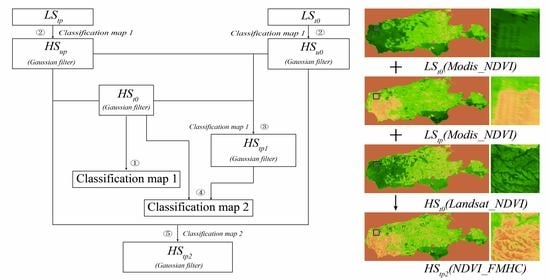An Effective High Spatiotemporal Resolution NDVI Fusion Model Based on Histogram Clustering
Abstract
1. Introduction
- (1)
- The NDVI_FMHC constructs an effective fusion framework using two kinds of classification maps which are automatically generated by histogram clustering method. Due to the classification map containing coarse-resolution information of the surface changes on the prediction date, the NDVI_FMHC forms an important contribution to improve the prediction accuracy of phenological and shape changes.
- (2)
- To reduce error, the NDVI_FMHC approach uses four strategies, namely, the construction of an overdetermined linear mixed model, multiscale prediction, residual distribution, and Gaussian filtering.
- (3)
- We have designed a friendly and concise software interface for the NDVI_FMHC, which will be shared with interested users. The NDVI_FMHC software can directly generate NDVI time-series data with a high spatial resolution by using one pair of cloudless basic NDVI data but with less computational costs and prior knowledge.
2. Method
2.1. Spatiotemporal Fusion Framework
2.2. Feature Description of Land Cover Classification
2.3. Estimation of NDVI Change with a Linear Mixture Model
2.4. Residuals and Its Allocation Formed by Predicting Time Changes
2.5. Gaussian Filtering
2.6. Block Effect Elimination and Final Prediction
3. Data
3.1. Test Dataset Preprocessing
3.2. Study Area and Data
3.3. Quality Evaluation Index
4. Analysis Results
4.1. Phenological Changes in Forest Area
4.2. Non-Shape Change in Cultivated Land Area
4.3. Shape Change in the Flood Area
4.4. Shape Change in Urban Area
4.5. Shape Change in the Fire Area
5. Discussion
5.1. Prediction Advantages of the NDVI_FMHC
5.2. Optimal Parameters of the NDVI_FMHC
5.3. Limitations of the NDVI_FMHC
6. Conclusions
Supplementary Materials
Author Contributions
Funding
Acknowledgments
Conflicts of Interest
References
- Kayastha, N.; Thomas, V.; Galbraith, J.; Banskota, A. Monitoring Wetland Change Using Inter-Annual Landsat Time-Series Data. Wetlands 2012, 32, 1149–1162. [Google Scholar] [CrossRef]
- Baassou, B.; He, M.; Mei, S.; Zhang, Y. Unsupervised hyperspectral image classification algorithm by integrating spatial-spectral information. In Proceedings of the International Conference on Audio, Language & Image Processing, Shanghai, China, 16 July 2012. [Google Scholar]
- Guo, B.; Zhou, Y.; Wang, S.; Tao, H. The relationship between normalized difference vegetation index (NDVI) and climate factors in the semiarid region: A case study in Yalu Tsangpo River basin of Qinghai-Tibet Plateau. J. Mt. Sci. Engl. 2014, 11, 926–940. [Google Scholar] [CrossRef]
- Wang, J.; Zhao, Y.; Li, C.; Yu, L.; Liu, D.; Gong, P. Mapping global land cover in 2001 and 2010 with spatial-temporal consistency at 250 m resolution. ISPRS J. Photogramm. Remote Sens. 2015, 103, 38–47. [Google Scholar] [CrossRef]
- Fan, X.; Liu, Y. A global study of NDVI difference among moderate-resolution satellite sensors. ISPRS J. Photogramm. Remote Sens. 2016, 121, 177–191. [Google Scholar] [CrossRef]
- De la Casa, A.; Ovando, G.; Bressanini, L.; Martinez, J.; Diaz, G.; Miranda, C. Soybean crop coverage estimation from NDVI images with different spatial resolution to evaluate yield variability in a plot. ISPRS J. Photogramm. 2018, 146, 531–547. [Google Scholar] [CrossRef]
- Laibao, L.; Yang, W.; Zheng, W.; Delong, L.; Yatong, Z.; Dahe, Q.; Shuangcheng, L. Elevation-dependent decline in vegetation greening rate driven by increasing dryness based on three satellite NDVI datasets on the Tibetan Plateau. Ecol. Indic. 2019, 107, 105569. [Google Scholar]
- Chu, H.; Venevsky, S.; Wu, C.; Wang, M. NDVI-based vegetation dynamics and its response to climate changes at Amur-Heilongjiang River Basin from 1982 to 2015. Sci. Total Environ. 2019, 650, 2051–2062. [Google Scholar] [CrossRef]
- Zhang, Y.; Ling, F.; Foody, G.M.; Ge, Y.; Boyd, D.S.; Li, X.; Du, Y.; Atkinson, P.M. Mapping annual forest cover by fusing PALSAR/PALSAR-2 and MODIS NDVI during 2007–2016. Remote Sens. Environ. 2019, 224, 74–91. [Google Scholar] [CrossRef]
- Gao, F.; Masek, J.; Schwaller, M.; Hall, F. On the blending of the Landsat and MODIS surface reflectance: Predicting daily Landsat surface reflectance. IEEE Trans. Geosci. Remote Sens. 2006, 44, 2207–2218. [Google Scholar]
- Zhu, X.; Jin, C.; Feng, G.; Chen, X.; Masek, J.G. An enhanced spatial and temporal adaptive reflectance fusion model for complex heterogeneous regions. Remote Sens. Environ. 2010, 114, 2610–2623. [Google Scholar] [CrossRef]
- Zhu, X.; Cai, F.; Tian, J.; Williams, T. Spatiotemporal Fusion of Multisource Remote Sensing Data: Literature Survey, Taxonomy, Principles, Applications, and Future Directions. Remote Sens. Basel 2018, 10, 527. [Google Scholar]
- Huete, A.; Didan, K.; Miura, T.; Rodriguez, E.P.; Gao, X.; Ferreira, L.G. Overview of the radiometric and biophysical performance of the MODIS vegetation indices. Remote Sens. Environ. 2002, 83, 195–213. [Google Scholar] [CrossRef]
- Fensholt, R.; Rasmussen, K.; Nielsen, T.T.; Mbow, C. Evaluation of earth observation based long term vegetation trends—Intercomparing NDVI time series trend analysis consistency of Sahel from AVHRR GIMMS, Terra MODIS and SPOT VGT data. Remote Sens. Environ. 2009, 113, 1886–1898. [Google Scholar] [CrossRef]
- Abdollah, J.; Tim, M.V.; Thomas, V.N.; Irina, E.; John, C.; Kasper, J. Blending landsat and MODIS data to generate multispectral indices: A comparison of “index-then-blend” and “Blend-Then-Index” approaches. Remote Sens. Basel 2014, 6, 9213–9238. [Google Scholar]
- Chen, X.; Liu, M.; Zhu, X.; Chen, J.; Zhong, Y.; Cao, X. “Blend-then-Index” or “Index-then-Blend”: A Theoretical Analysis for Generating High-resolution NDVI Time Series by STARFM. Photogramm. Eng. Remote Sens. 2018, 84, 65–73. [Google Scholar] [CrossRef]
- Liu, X.; Deng, C.; Chanussot, J.; Hong, D.; Zhao, B. StfNet: A Two-Stream Convolutional Neural Network for Spatiotemporal Image Fusion. IEEE Trans. Geosci. Remote Sens. 2019, 57, 6552–6564. [Google Scholar] [CrossRef]
- Rao, Y.; Zhu, X.; Chen, L.; Wang, J.; Chen, J. An Improved Method for Producing High Spatial-Resolution NDVI Time Series Datasets with Multi-Temporal MODIS NDVI Data and Landsat TM/ETM+ Images. Remote Sens. Basel 2015, 7, 7865–7891. [Google Scholar] [CrossRef]
- Belgiu, M.; Stein, A. Spatiotemporal Image Fusion in Remote Sensing. Remote Sens. Basel 2019, 11, 818. [Google Scholar] [CrossRef]
- Hilker, T.; Wulder, M.A.; Coops, N.C.; Linke, J.; Mcdermid, G.; Masek, J.G.; Gao, F.; White, J.C. A new data fusion model for high spatial- and temporal-resolution mapping of forest disturbance based on Landsat and MODIS. Remote Sens. Environ. 2009, 113, 1613–1627. [Google Scholar] [CrossRef]
- Wu, P.; Shen, H.; Zhang, L.; Göttsche, F.M. Integrated fusion of multi-scale polar-orbiting and geostationary satellite observations for the mapping of high spatial and temporal resolution land surface temperature. Remote Sens. Environ. 2015, 156, 169–181. [Google Scholar] [CrossRef]
- Ma, J.; Zhang, W.; Marinoni, A.; Gao, L.; Zhang, B. An Improved Spatial and Temporal Reflectance Unmixing Model to Synthesize Time Series of Landsat-Like Images. Remote Sens. Basel 2018, 10, 1388. [Google Scholar] [CrossRef]
- Bo, H.; Zhang, H. Spatio-temporal reflectance fusion via unmixing: Accounting for both phenological and land-cover changes. Int. J. Remote Sens. 2014, 35, 6213–6233. [Google Scholar]
- Zhu, X.; Helmer, E.H.; Gao, F.; Liu, D.; Chen, J. A flexible spatiotemporal method for fusing satellite images with different resolutions. Remote Sens. Environ. 2016, 172, 165–177. [Google Scholar] [CrossRef]
- Huang, B.; Song, H. Spatiotemporal Reflectance Fusion via Sparse Representation. IEEE Trans. Geosci. Remote Sens. 2012, 50, 3707–3716. [Google Scholar] [CrossRef]
- Chen, B.; Huang, B.; Xu, B. A hierarchical spatiotemporal adaptive fusion model using one image pair. Int. J. Digit. Earth 2017, 10, 639–655. [Google Scholar] [CrossRef]
- Zhong, D.; Zhou, F. Improvement of Clustering Methods for Modelling Abrupt Land Surface Changes in Satellite Image Fusions. Remote Sens. Basel 2019, 11, 1759. [Google Scholar] [CrossRef]
- Zhao, Y.; Huang, B.; Song, H. A robust adaptive spatial and temporal image fusion model for complex land surface changes. Remote Sens. Environ. 2018, 208, 42–62. [Google Scholar] [CrossRef]
- Maselli, F.; Rembold, F. Integration of LAC and GAC NDVI data to improve vegetation monitoring in semi-arid environments. Int. J. Remote Sens. 2002, 23, 2475–2488. [Google Scholar] [CrossRef]
- Liao, L.; Song, J.; Wang, J.; Xiao, Z.; Jian, W. Bayesian Method for Building Frequent Landsat-Like NDVI Datasets by Integrating MODIS and Landsat NDVI. Remote Sens. Basel 2016, 8, 452. [Google Scholar] [CrossRef]
- Liu, M.; Yang, W.; Zhu, X.; Chen, J.; Chen, X.; Yang, L.; Helmer, E.H. An Improved Flexible Spatiotemporal DAta Fusion (IFSDAF) method for producing high spatiotemporal resolution normalized difference vegetation index time series. Remote Sens. Environ. 2019, 227, 74–89. [Google Scholar] [CrossRef]
- Chen, X.; Li, W.; Chen, J.; Rao, Y.; Yamaguchi, Y. A Combination of TsHARP and Thin Plate Spline Interpolation for Spatial Sharpening of Thermal Imagery. Remote Sens. 2014, 6, 2845–2863. [Google Scholar] [CrossRef]
- Xie, D.; Zhang, J.; Zhu, X.; Pan, Y.; Liu, H.; Yuan, Z.; Yun, Y. An Improved STARFM with Help of an Unmixing-Based Method to Generate High Spatial and Temporal Resolution Remote Sensing Data in Complex Heterogeneous Regions. Sensors-Basel 2016, 16, 207. [Google Scholar] [CrossRef] [PubMed]
- Weng, Q.; Fu, P.; Gao, F. Generating daily land surface temperature at Landsat resolution by fusing Landsat and MODIS data. Remote Sens. Environ. 2014, 145, 55–67. [Google Scholar] [CrossRef]
- Zhang, H.K.; Zhang, M.; Huang, B.; Cao, K.; Yu, L. A generalization of spatial and temporal fusion methods for remotely sensed surface parameters. Int. J. Remote Sens. 2015, 36, 4411–4445. [Google Scholar] [CrossRef]
- Sun, Y.; Zhang, H.; Shi, W. A spatio-temporal fusion method for remote sensing data Using a linear injection model and local neighbourhood information. Int. J. Remote Sens. 2019, 40, 2965–2985. [Google Scholar] [CrossRef]
- Emelyanova, I.V.; Mcvicar, T.R.; Van Niel, T.G.; Li, L.T.; Van Dijk, A.I.J.M. Assessing the accuracy of blending Landsat–MODIS surface reflectances in two landscapes with contrasting spatial and temporal dynamics: A framework for algorithm selection. Remote Sens. Environ. 2013, 133, 193–209. [Google Scholar] [CrossRef]
- Cammalleri, C.; Anderson, M.C.; Gao, F.; Hain, C.R.; Kustas, W.P. A data fusion approach for mapping daily evapotranspiration at field scale. Water Resour. Res. 2013, 49, 4672–4686. [Google Scholar] [CrossRef]
- Wang, Z.; Bovik, A.C.; Sheikh, H.R.; Simoncelli, E.P. Image quality assessment: From error visibility to structural similarity. IEEE Trans. Image Process. 2004, 13, 600–612. [Google Scholar] [CrossRef]
- Yao, W.; Loffeld, O.; Datcu, M. Application and Evaluation of a Hierarchical Patch Clustering Method for Remote Sensing Images. IEEE J. Sel. Top. Appl. Earth Obs. Remote Sens. 2016, 9, 2279–2289. [Google Scholar] [CrossRef]
- Dubey, S.K.; Vijay, S. A Review of Image Segmentation using Clustering Methods. Int. J. Appl. Eng. Res. 2018, 13, 2484–2489. [Google Scholar]
- Buch, A.G.; Kraft, D. Local Point Pair Feature Histogram for Accurate 3D Matching. In Proceedings of the 29th British Machine Vision Conference, BMVC, Newcastle, UK, 11 September 2018; pp. 1–12. [Google Scholar]
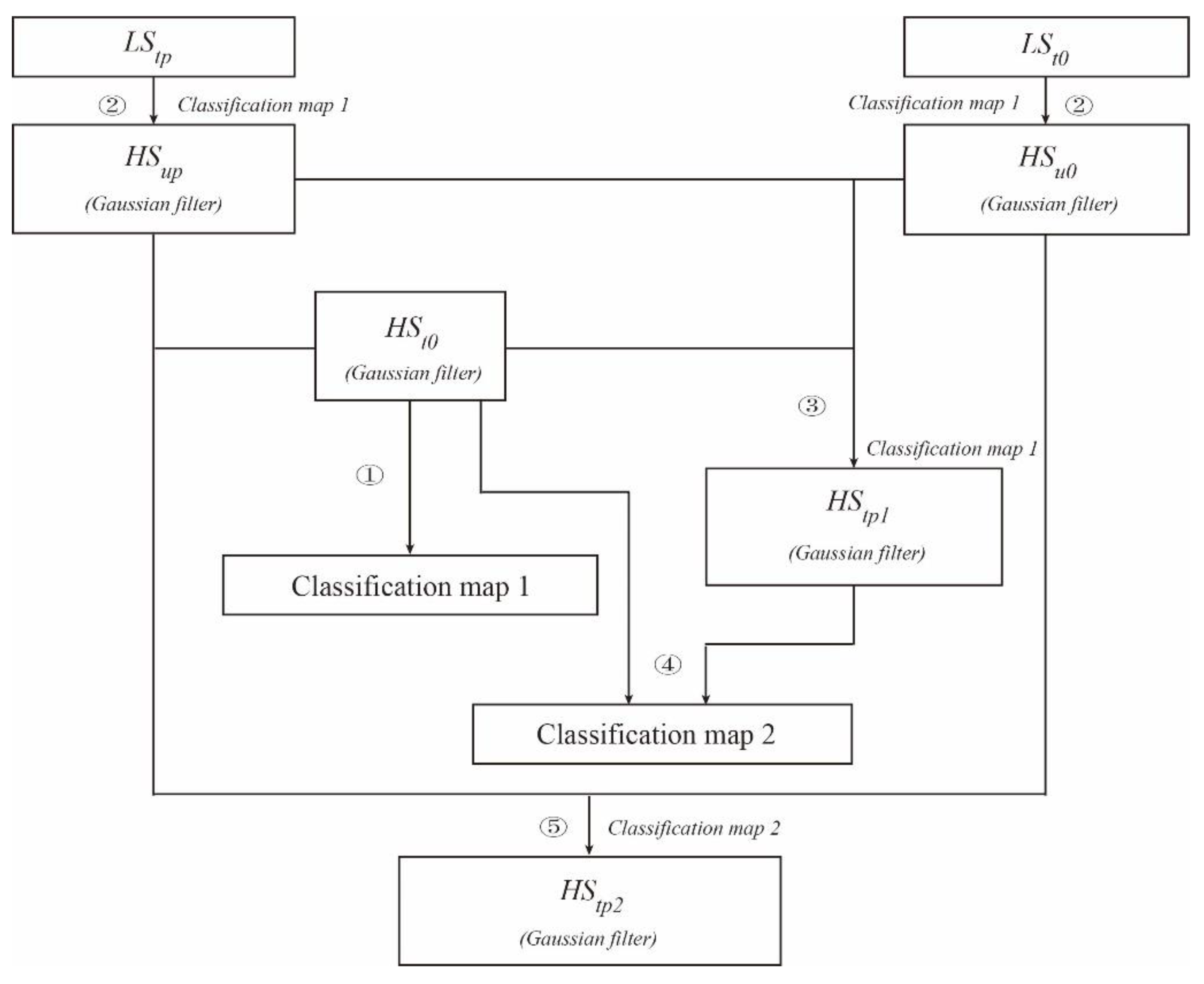
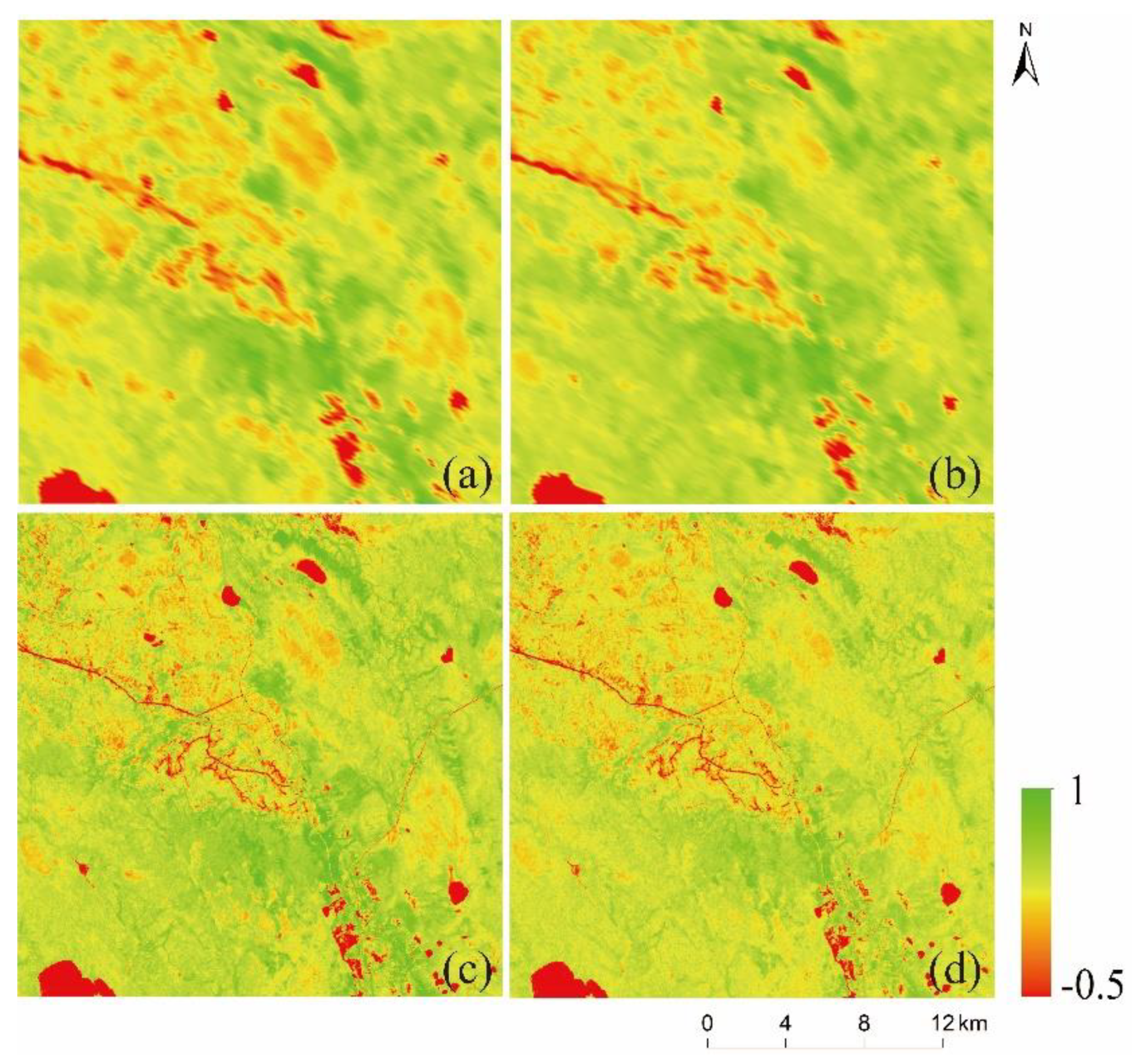


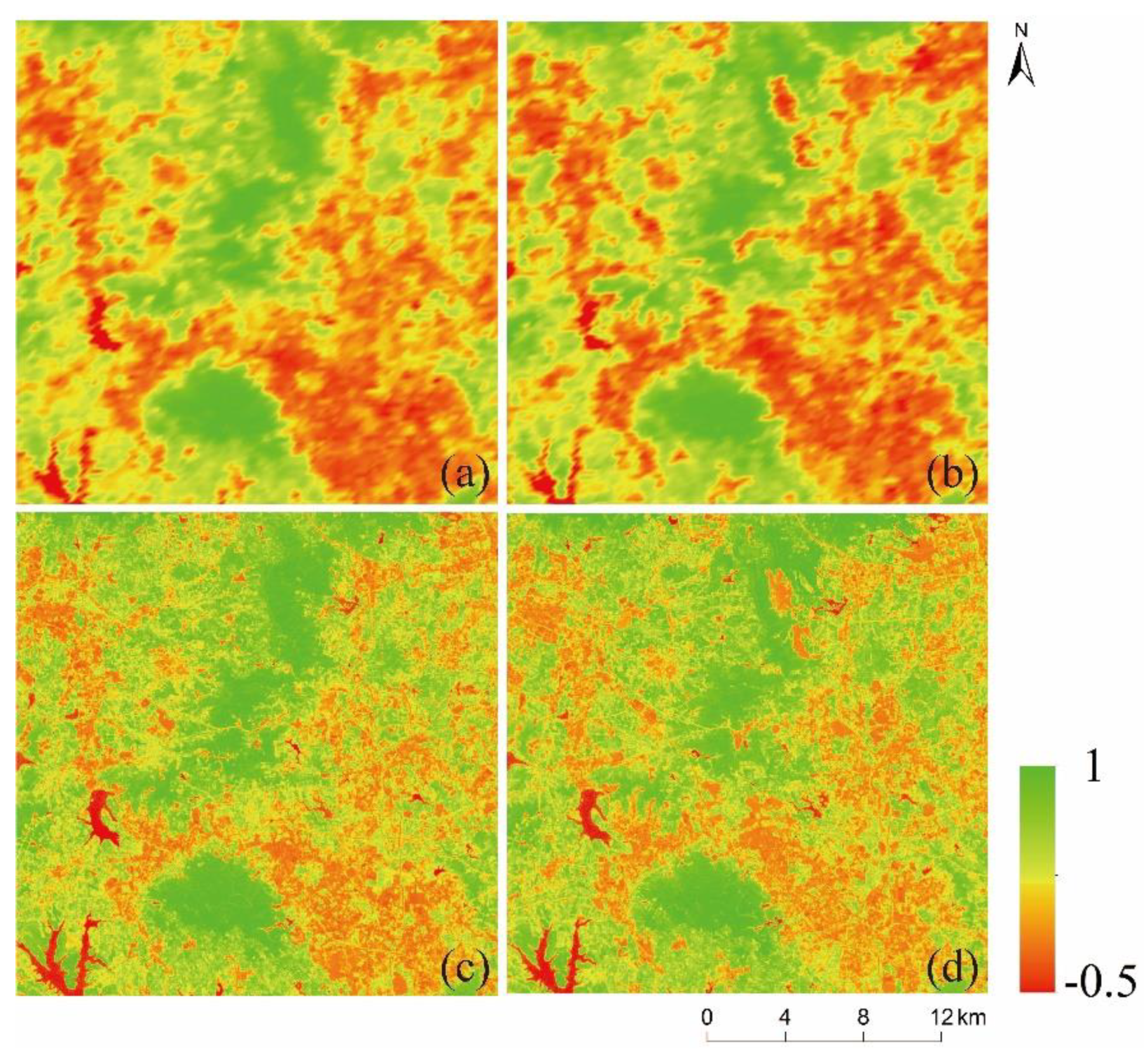
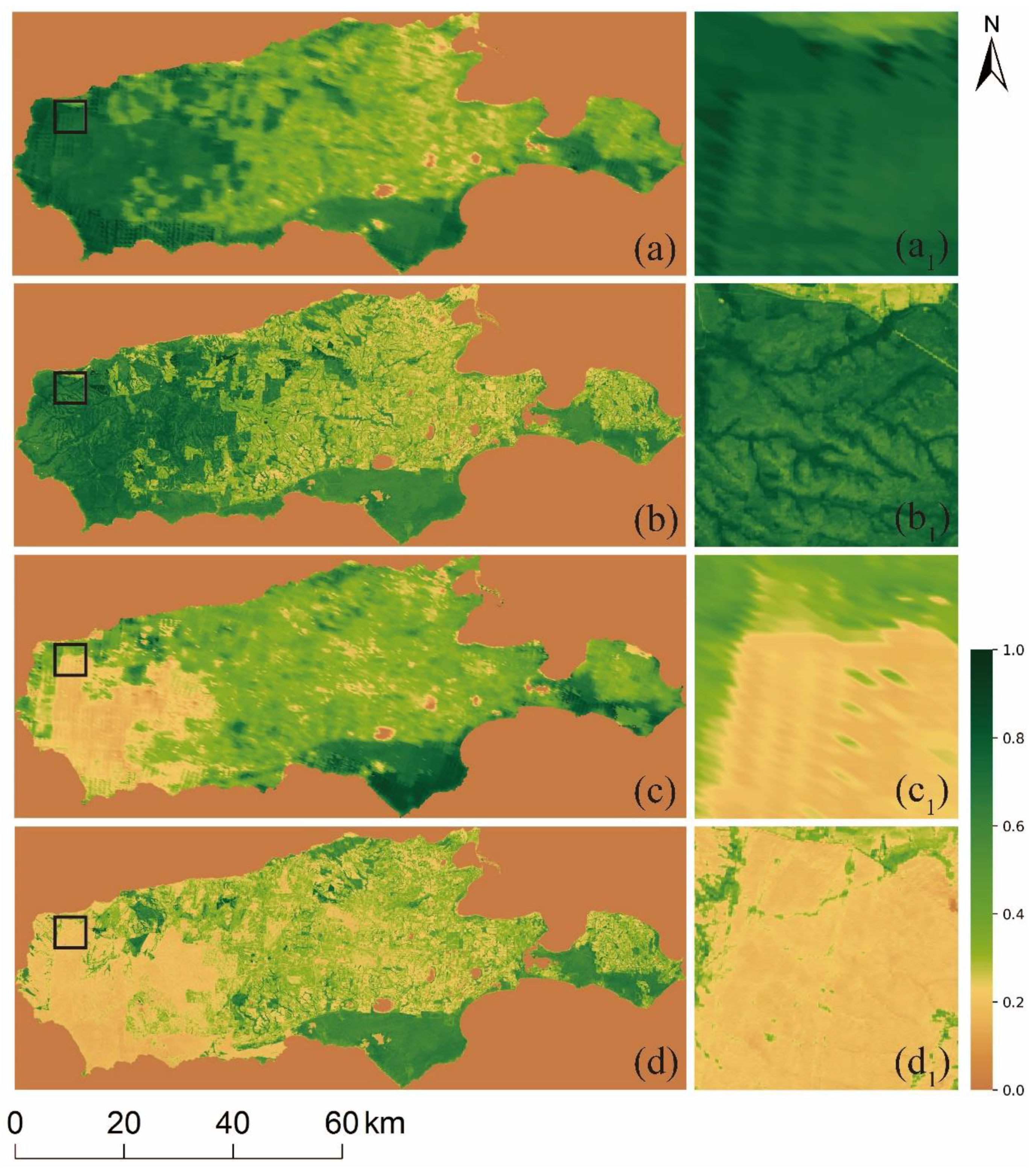








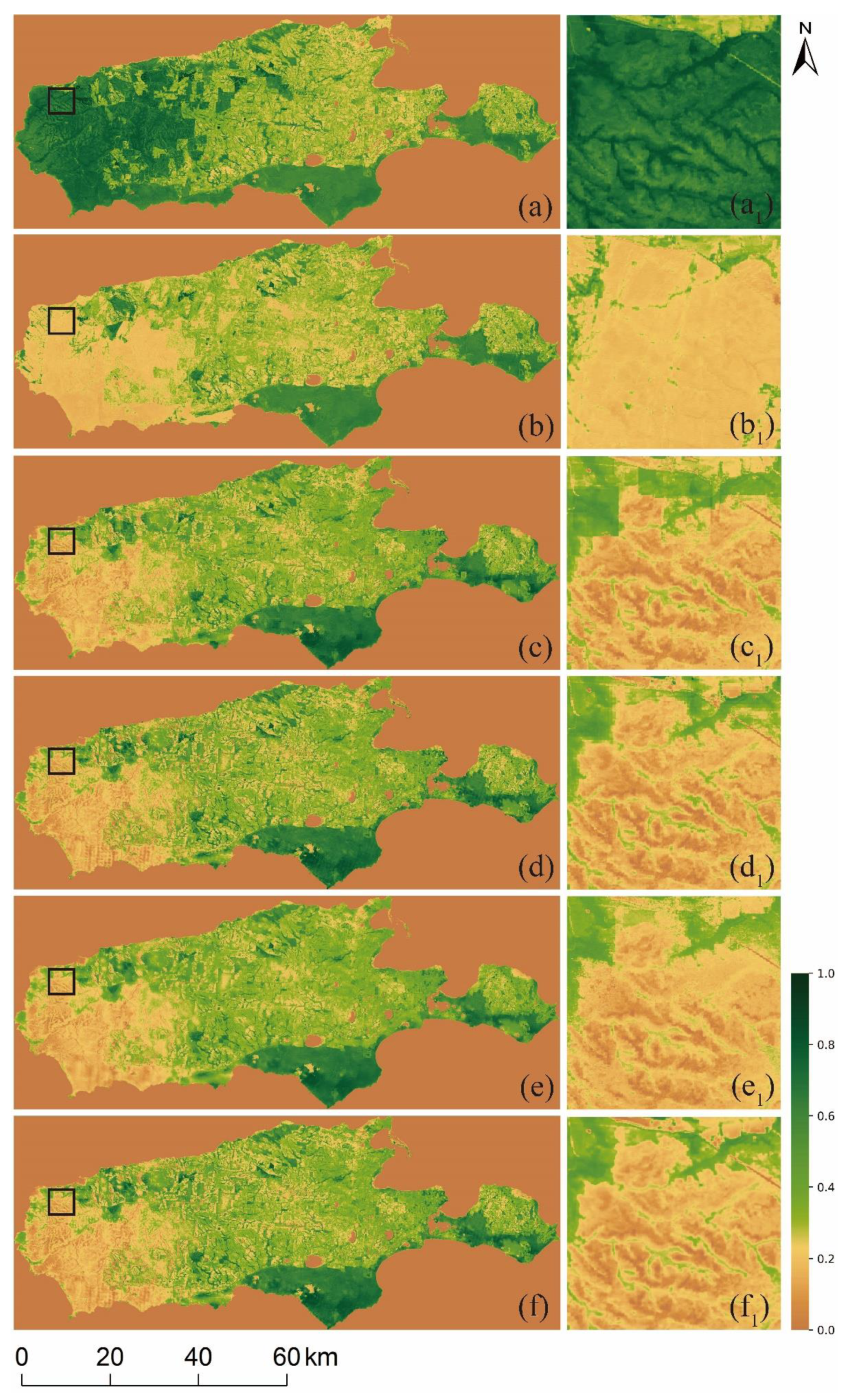
| Symbol Name | Symbol Brief Description |
|---|---|
| Base date | |
| Prediction date | |
| Landsat_NDVI data at | |
| MODIS_NDVI data at | |
| MODIS_NDVI data at | |
| Landsat resolution data generated from MODIS_NDVI data sampling at | |
| Landsat resolution data generated from MODIS_NDVI data sampling at | |
| Predicted Landsat_NDVI data based on classification map 1 | |
| Predicted Landsat_NDVI data based on classification map 2 |
| Name\Indicator | Landsat 12 August 2001 | ESTARFM | NDVI-LMGM | FSDAF | NDVI_FMHC |
|---|---|---|---|---|---|
| r | 0.9377 | 0.9363 | 0.8996 | 0.9405 | 0.9488 |
| AAD | 0.0346 | 0.0258 | 0.0321 | 0.0247 | 0.0229 |
| AE | 0.0263 | 0.0006 | 0.0002 | −0.0002 | 0.0000 |
| RMSE | 0.0496 | 0.0417 | 0.0536 | 0.0408 | 0.0373 |
| SSIM | 0.9436 | 0.9436 | 0.9100 | 0.9470 | 0.9548 |
| Name\Indicator | Landsat 22 August 2004 | ESTARFM | NDVI-LMGM | FSDAF | NDVI_FMHC |
|---|---|---|---|---|---|
| r | 0.8240 | 0.9295 | 0.9388 | 0.9453 | 0.9493 |
| AAD | 0.1129 | 0.0676 | 0.0639 | 0.0624 | 0.0605 |
| AE | −0.0653 | 0.0250 | 0.0215 | 0.0213 | 0.0204 |
| RMSE | 0.1657 | 0.1025 | 0.0954 | 0.0906 | 0.0869 |
| SSIM | 0.8123 | 0.9299 | 0.9396 | 0.9459 | 0.9494 |
| Name\Indicator | Landsat 12 December 2004 | ESTARFM | NDVI-LMGM | FSDAF | NDVI_FMHC |
|---|---|---|---|---|---|
| r | 0.6625 | 0.8027 | 0.8365 | 0.8311 | 0.8450 |
| AAD | 0.1222 | 0.1052 | 0.0960 | 0.1003 | 0.0968 |
| AE | −0.0064 | −0.0468 | −0.0457 | −0.0455 | −0.0458 |
| RMSE | 0.1646 | 0.1367 | 0.1265 | 0.1284 | 0.1245 |
| SSIM | 0.5643 | 0.7710 | 0.8080 | 0.7953 | 0.8072 |
| Name\Indicator | Landsat 12 August 2001 | ESTARFM | NDVI-LMGM | FSDAF | NDVI_FMHC |
|---|---|---|---|---|---|
| r | 0.8224 | 0.8590 | 0.8691 | 0.8719 | 0.8855 |
| AAD | 0.0868 | 0.0811 | 0.0807 | 0.0782 | 0.0756 |
| AE | 0.0234 | 0.009 | 0.0108 | 0.0108 | 0.0109 |
| RMSE | 0.1338 | 0.1154 | 0.1132 | 0.1103 | 0.1047 |
| SSIM | 0.8271 | 0.8594 | 0.8728 | 0.8711 | 0.8850 |
| Name\Indicator | Landsat 10 February 2020 | ESTARFM | NDVI-LMGM | FSDAF | NDVI_FMHC |
|---|---|---|---|---|---|
| r | 0.2792 | 0.8489 | 0.8333 | 0.8363 | 0.8417 |
| AAD | 0.1785 | 0.0738 | 0.0780 | 0.0733 | 0.0749 |
| AE | 0.1600 | 0.0290 | 0.02259 | 0.0281 | 0.0257 |
| RMSE | 0.2772 | 0.1019 | 0.1092 | 0.1021 | 0.1035 |
| SSIM | 0.2812 | 0.8463 | 0.8274 | 0.8389 | 0.8399 |
Publisher’s Note: MDPI stays neutral with regard to jurisdictional claims in published maps and institutional affiliations. |
© 2020 by the authors. Licensee MDPI, Basel, Switzerland. This article is an open access article distributed under the terms and conditions of the Creative Commons Attribution (CC BY) license (http://creativecommons.org/licenses/by/4.0/).
Share and Cite
Xing, X.; Yan, C.; Jia, Y.; Jia, H.; Lu, J.; Luo, G. An Effective High Spatiotemporal Resolution NDVI Fusion Model Based on Histogram Clustering. Remote Sens. 2020, 12, 3774. https://doi.org/10.3390/rs12223774
Xing X, Yan C, Jia Y, Jia H, Lu J, Luo G. An Effective High Spatiotemporal Resolution NDVI Fusion Model Based on Histogram Clustering. Remote Sensing. 2020; 12(22):3774. https://doi.org/10.3390/rs12223774
Chicago/Turabian StyleXing, Xuegang, Changzhen Yan, Yanyan Jia, Haowei Jia, Junfeng Lu, and Guangjie Luo. 2020. "An Effective High Spatiotemporal Resolution NDVI Fusion Model Based on Histogram Clustering" Remote Sensing 12, no. 22: 3774. https://doi.org/10.3390/rs12223774
APA StyleXing, X., Yan, C., Jia, Y., Jia, H., Lu, J., & Luo, G. (2020). An Effective High Spatiotemporal Resolution NDVI Fusion Model Based on Histogram Clustering. Remote Sensing, 12(22), 3774. https://doi.org/10.3390/rs12223774




